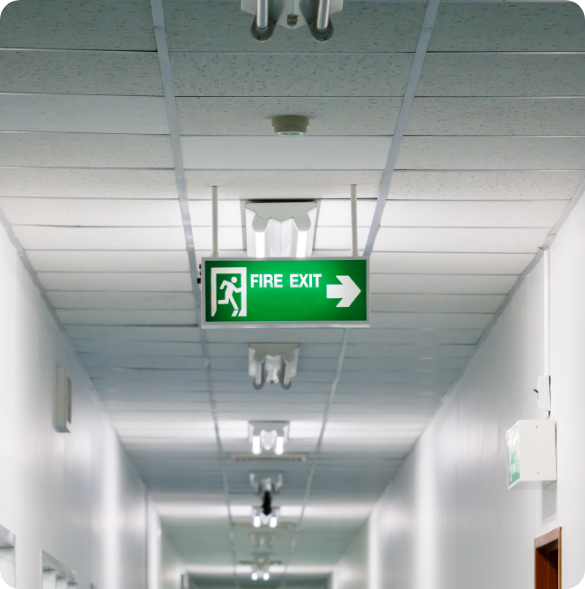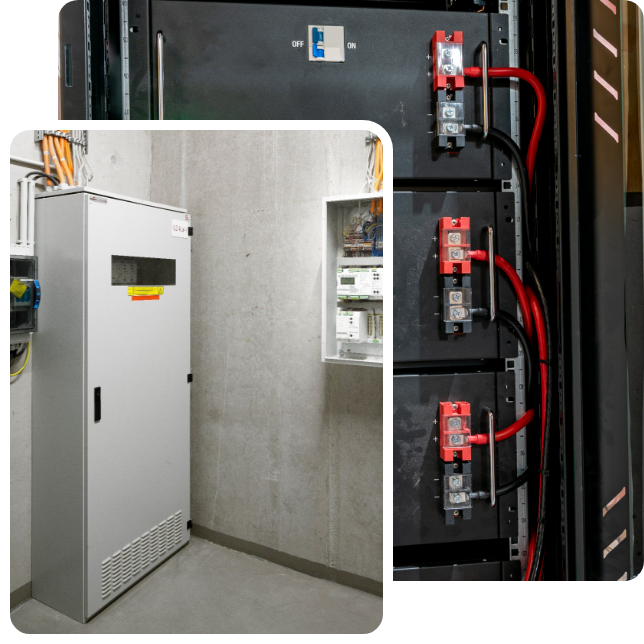Sygma Services
Emergency Lighting Systems
Emergency lighting systems are designed to reduce the panic that may begin following the activation of a fire alarm and assist in evacuation scenarios with low visibility caused by smoke, fire hazards and power failure.

Types of Emergency Lighting Systems
There are three main types of emergency lighting systems which can be installed to increase visibility during a fire.
Escape
Escape lighting is designed to illuminate escape routes and provide occupants with a clear exit path.
High amounts of smoke caused by a fire can severely reduce visibility even if the primary lighting system remains functional. Smoke also forces occupants to stay low to the ground which can cause further disorientation and make navigation difficult as regular visual cues used may not be visible.
In addition to lighting, additional luminary signs can be used to direct people to the nearest exit.
Escape lighting should be installed along corridors and stairways as well as around the location of doors and fire exits. Crucial safety equipment such as fire should also be covered.
Open Area
Open area, sometimes known as “anti-panic” lighting systems are used within buildings with high numbers of people and large open areas, for example train stations and shopping centres. Visibility may be reduced but escape routes and fire exits will still be identifiable.
Standby lighting helps to reduce panic that may be caused by total darkness, especially in public buildings which attract high numbers of visitors, most of whom will be unfamiliar with the building layout.
High-Risk Task Area
Used within high-risk environments during emergencies. Provides lighting for emergency personnel to carry out essential procedures and identify any equipment which needs to be turned off in the event of an emergency.

Types of Batteries
Emergency lighting systems operate on a separate power supply than the primary lighting. Systems can be powered from a central source or be self-contained. Regardless of the power source, lighting must remain on for at least 3 hours. some systems will recharge after use however systems should be checked to ensure all components are in good working order.
Self-Contained
Self-contained units contain their own power supply with internal batteries and functions as independent sources of light. These are the most widely used form of emergency lighting, commonly seen attached to a wall or ceiling to illuminate key areas of the building.
Relatively quick and easy to install as all essential components are fitted within the unit. This allows greater flexibility during installation as location will not be restricted by cables or distance from a central power supply.
The downside is that these units have limited lamp power and a shorter battery life, meaning they are not suitable for hazardous environments. The cost of periodic testing may be higher than a central system.
Get in TouchCentral Battery System
Connected to central power supply meaning they can not function independently. The unit includes the lamp however a central battery and charger will be located remotely.
Central systems are less expensive and have a longer battery life. However, this system will often require a battery cabinet and separate wiring which makes them less flexible and more difficult to install. Regular battery maintenance will be required and the system will not function if the central battery is damaged.

Maintained vs Non-Maintained Modes of Operation
There are two modes of operation depending on the function of the building and intended use. Lights can remain on constantly or activate only during an emergency.
Maintained
Maintained systems have the option to be switched on or off, although they are generally always on.They are connected to a regular lighting system for daily operation and powered by a back-up system during emergency scenarios. Commonly used in public spaces where occupants may not be familiar with the layout, such as shopping centres, and also in situations where the lighting may be low, for example a movie theatre or nightclub.
Non Maintained
Non-maintained are only activated when the primary lighting source fails. Used in buildings which are regularly well lit. These systems are usually powered by an internal battery which will recharge once power has been restored.
Installation
A fire risk assessment should be completed to ensure adequate emergency lighting has been provided. Professional assessment will allow for all building variables to be taken into account, such as the variation in lighting conditions between different areas of the building, building function and risk to occupants.
It is essential that certain areas and building features are covered. These include: exit doors, escape routes, corridor intersections, escape signs, stairways and changes to floor level, windowless rooms, toilets larger than 8m², safety equipment, lifts.
Rooms with large windows which benefit from high amounts of borrowed light from an external source may not require emergency lighting, whereas dimly lit corridors or stairwells which do not receive lighting from an external source will require some form of lighting.
Time of occupancy must also be considered. Buildings occupied at night by the public will always require some form of emergency lighting, even when borrowed light is present. This is because the general public may not be familiar with the building layout and may include individuals who are visually impaired.
However, if the premise is only occupied by staff who are familiar with the building, and the building has a clear escape path then borrowed lighting may be adequate, even during the night. Small (up to 60 people) and medium (up to 300 people) buildings can utilize borrowed light but large buildings (over 300) must use some form of emergency lighting.

Regulation
Regulatory Reform Fire Safety Order (FSO) 2005 says that the responsible person must ensure the safety of all occupants, which may include the provision of emergency lighting. The responsible person is legally accountable. This may be the owner, landlord, letting agent or property manager.
Article 14 (2) (h) of the RRFSO states: “Emergency routes and exits requiring illumination must be provided with emergency lighting of adequate intensity in the case of failure of their normal lighting”.
The British Standard BS 5266-1: 2016 recommends the standard required, and EN 1838 governs the product standard that should be installed.
How can we help?
At Sygma, we work with you to recommend design and installation solutions based on the emergency exit plan developed in your Fire Risk Assessment . Our solutions can vary from fully integrated systems that also provide programmable low lighting for periods of reduced occupation (such as overnight) to stand-alone systems that function only in power failure scenarios.
Our systems that we install are state of the art low voltage, intelligent lighting units which communicate with the control hub, reporting on their charge and operational state at regular intervals. The system is therefore able to identify issues and failures at the earliest possible point in time, reducing downtime and extensive maintenance costs. The nature of the low voltage output also has significant cost benefits in regard to operational costs and help companies to reduce their environmental emissions footprint.
Contact Us
We’re proud to protect our clients across the UK.
54 Poland St
London
W1F 7NJ
Sygma - Kent Office
Unit 4A Geerings Business Centre
Kent
TN23 1EP
Sygma - Suffolk Office
Unit K, Blois Meadow Business Centre
Suffolk
CB9 7BN